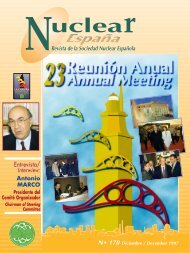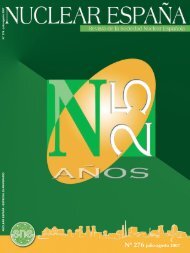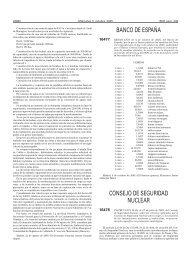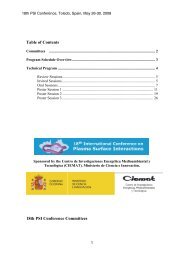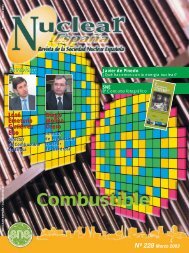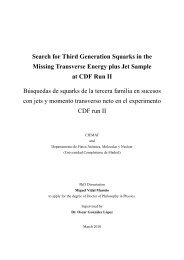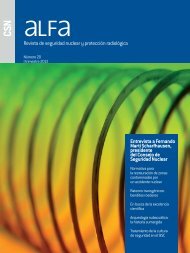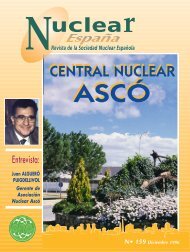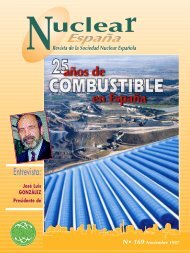EntrEntr evista/evista/ InterInter viewview
EntrEntr evista/evista/ InterInter viewview
EntrEntr evista/evista/ InterInter viewview
Create successful ePaper yourself
Turn your PDF publications into a flip-book with our unique Google optimized e-Paper software.
CENTRALES NUCLEARES/NUCLEAR POWER PLANTS<br />
1998 1999<br />
Producción/Production (GWh) 59.002 58.852<br />
Nº de Paradas para Recarga/Nº of Refueling Outages 4 7<br />
Factor de Carga/Load Factor (%) 88,4 87,4<br />
Factor de Operación/Operating Factor (%) 91,3 90,0<br />
Factor de Disponibilidad/Capability Factor (%) 90,1 88,5<br />
Factor de Indisp. No Programada/ 6,1 2,6<br />
Unplanned Capability Loss Factor (%)<br />
Paradas no Programadas por reactor/<br />
Nº of Scrams per Reactor<br />
• Automáticas/Automatic 0,9 1,7<br />
• Total (automáticas y manuales) 1,2 2,8<br />
Total (automatic and manual)<br />
Potencia instalada a 31.12.99 (MWe) 7.637,8 7.749,1<br />
Installed Power at 31.12.99<br />
Otro dato relevante del balance<br />
eléctrico de 1999 ha sido el fuerte<br />
aumento, un año mas, tanto de la<br />
generación en régimen especial como<br />
de las ventas que estos productores<br />
realizaron a las empresas eléctricas<br />
en forma de excedentes. Las<br />
estimaciones de UNESA indican<br />
que la generación en régimen especial<br />
se situó en 32.935 millones de<br />
kWh, cifra que representa el 15,8%<br />
de la producción total de electricidad<br />
del país. El 75% de dicha cantidad<br />
fue vendido a las empresas<br />
eléctricas. En cifras absolutas, esta<br />
energía vendida fue de 24.648 millones<br />
de kWh, un 21,9% más que<br />
el año precedente. Esto supone que,<br />
al igual que en ejercicios anteriores,<br />
las ventas de electricidad del régimen<br />
especial al sistema eléctrico<br />
aumentaron claramente por encima<br />
del correspondiente a la producción<br />
total.<br />
Por su parte, los intercambios internacionales<br />
han registrado una<br />
vez más un saldo importador que,<br />
en 1999, fue de 5.715 millones de<br />
kWh.<br />
En relación con la potencia instalada,<br />
referida a datos de las<br />
Empresas Eléctricas miembros de<br />
UNESA, se ha de destacar que en<br />
1999 se pusieron en servicio 336<br />
MW de los que 111 MW fueron debidos<br />
a incrementos de la potencia<br />
nominal de las centrales nucleares<br />
de Ascó II y Vandellós II; de los restantes,<br />
158 MW corresponden al<br />
equipo hidroeléctrico (central de<br />
Ricobayo) y 67 MW al equipo térmico<br />
convencional (una ampliación<br />
del grupo 3 de la central térmica de<br />
Narcea, un grupo en Formentera y<br />
otro en Mahón). La potencia dada<br />
de baja fue de 17,9 MW, con lo que<br />
la potencia total instalada por las<br />
empresas de UNESA a 31 de<br />
Diciembre de 1999 se cifra en<br />
46.552 MW.<br />
LA CONTRIBUCIîN<br />
DE LAS CENTRALES NUCLEARES<br />
AL A„O ELƒCTRICO<br />
Tal como está previsto en el programa,<br />
los Jefes de las centrales nucleares<br />
españolas les contarán a<br />
continuación los resultados y experiencias<br />
específicos de cada una de<br />
ellas. Por mi parte, yo me referiré a<br />
los datos globales de todas ellas para<br />
destacar lo que ha representado<br />
la energía nuclear en el conjunto<br />
del Sector Eléctrico Español.<br />
En el año1999, las centrales nucleares<br />
han continuado demostrando<br />
su capacidad de competir con<br />
cualquier otra fuente de generación<br />
de energía eléctrica. Los precios<br />
ofertados de su producción las han<br />
conducido, también en este año, a<br />
ser seleccionadas para funcionar de<br />
forma continua durante el mismo.<br />
En 1999 la producción de origen<br />
nuclear ha alcanzado los 58.852<br />
millones de kWh, lo que ha constituido<br />
el segundo mejor registro de<br />
su historia. No obstante, hay que<br />
has been confirmed by electricity consumption for<br />
final use. Low voltage consumption, representing<br />
47.6% of the total demand, has shown the most<br />
dynamic increase in 1999, with an increase of 7.8%.<br />
High voltage consumption, representing 52.4% of<br />
the total, has undergone a more moderate increase<br />
of 5.3%. In both cases, the growth figures are similar<br />
to those seen in 1998.<br />
For its part, electricity production in Spain<br />
reached 208,223 million kWh, an increase of 6.2%<br />
over the previous year. By fuel types, conventional<br />
thermal-electricity generation represented 57% of<br />
the total, showing an increase of 21.2%, while<br />
nuclear and hydroelectricity production represented<br />
28.3% and 14.7%, respectively, reflecting decreases<br />
of 22%, in the case of hydroelectricity, and 0.2% in<br />
nuclear power. In hydroelectricity terms, 1999 may<br />
be said to have been a year of low hydraulicity.<br />
Another relevant pointer as regards the electricity<br />
balance in 1999 has been the strong increase, for yet<br />
another year, in both generation within the special<br />
regime and in the sales made by these producers to<br />
the electricity utilities as surpluses. UNESA<br />
estimates place generation within the special regime<br />
at 32,935 million kWh, a figure representing 15.8%<br />
of the country’s total electricity. Of this production,<br />
75% was sold to the utilities. In absolute figures, this<br />
energy sold amounted to 24,648 million kWh,<br />
21.9% more than during the previous year. As in the<br />
past, this means that sales to the electricity system by<br />
producers included in the special regime increased<br />
clearly over the increase shown by total production.<br />
International energy exchanges have once again<br />
leaned towards imports, which in 1999 amounted to<br />
5,715 million kWh.<br />
As regards installed capacity, and in reference to<br />
UNESA member utilities, it should be pointed out<br />
that 336 MWe were put into service during 1999,<br />
111 MW of which were the result of the uprating of<br />
the Ascó II and Vandellós II nuclear power plants. Of<br />
the rest, 158 MW corresponded to hydroelectricity<br />
equipment (Ricobayo plant) and 67 MW to<br />
conventional thermal installations (extension of unit<br />
3 of the Narcea thermal power plant, one unit in<br />
Formentera and another in Mahón). The capacity<br />
removed from the system amounted to 17.9 MW,<br />
with which the total installed capacity of the UNESA<br />
companies stood at 46,552 MW as of 31st<br />
December 1999.<br />
CONTRIBUTION OF THE NUCLEAR POWER<br />
PLANTS TO THE ELECTRICAL YEAR<br />
As established in the programme, the Managers of<br />
the Spanish nuclear power plants will be reporting<br />
on the results and specific experiences of their<br />
respective installations. For my part, I should like to<br />
refer to the overall data for these plants in order to<br />
underline what nuclear power has represented<br />
within the Spanish Electricity Industry.<br />
Throughout 1999 the nuclear power plants have<br />
once again demonstrated their capacity to compete<br />
with any other source of electricity generation. As<br />
has been the case in the past, the prices offered for<br />
their production have led to their being selected for<br />
continuous operation throughout the year.<br />
In 1999, nuclear production reached 58,852<br />
million kWh, the second highest figure in the sector’s<br />
history. Nevertheless, it should be pointed out that<br />
when this historic maximum was attained (1998),<br />
only 4 of the plants experienced a refuelling outage,<br />
as against the seven that shut down for this purpose<br />
in 1999. This difference, of significance as regards<br />
the total time they are connected to the grid, has had<br />
a repercussion of 0.25% on the decrease in<br />
production.<br />
This apparent discrepancy is explained by the<br />
improvements achieved in the rated power levels of<br />
Vandellós II and Ascó unit II, which have meant a<br />
A b r i l 2 0 0 0<br />
R e v i s t a S N E





